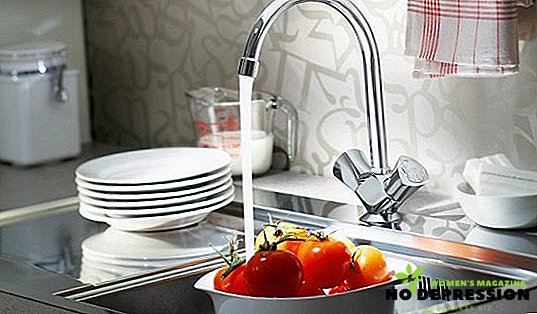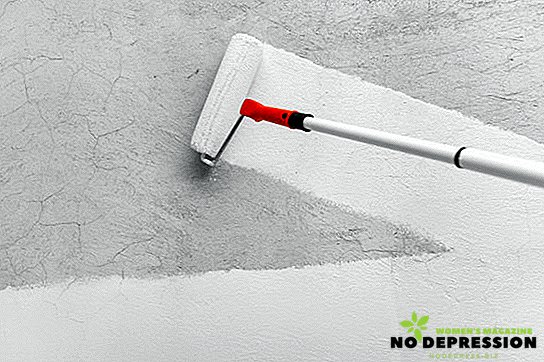Mixer - an important attribute of the kitchen. After all, it would be desirable that the water did not splash, the mixer did not get stained with divorces, served for a long time and did not break every month. This article will help to figure out which mixer should be purchased, and which one to ignore.

Selection by appearance
For many housewives, appearance is one of the components of choice. The design of the mixer should be in complete harmony with the overall style of the kitchen. Many of them are enameled. She is beautiful, but rather quickly loses integrity, if physical force is used when using the product. Stainless steel is much stronger, but you need to carefully care for it. Chrome - the most practical option of all presented.
Also often pay attention to the height of the crane, the appearance of the valve. Many cranes in our time are equipped with a built-in filtration system. It makes it possible to supply purified drinking water without requiring installation of equipment for cleaning and additional drainage. Usually such mixers are compatible with any filtration systems.
To make the equipment look harmonious, the sink and faucet must be selected in the same style.
For example, concise sinks in high-tech style are very often found in modern kitchens. In such interiors as classic, country or shebby chic, gold, bronze or copper versions look great.
In the Scandinavian variants, stone or stainless steel trim is most common. Color washing, mixer and valve is of great importance. Their color scheme depends on the color and overall finish of the entire kitchen. For round washing is best to use a round faucet. For a square-shaped sink, a G-shaped tap is needed.
Single lever kitchen faucets
Single lever - this is the most common form in modern kitchens. It is also called joystick. It consists of a body with a plate. In this case cold and hot water mix. And the plate is a kind of lever. Such a mixer is made of ceramic, metal or plastic.

If there are any problems with the mixer, you need to disassemble it in order to fix them. And for this you need to know the design of this device.
They are divided into two types:
- Sharovy. In it the main element is a small metal ball, which is located in the body of the crane. This ball has three special holes that are designed for three types of water: hot, cold and warm. The ball is in close contact with rubber "saddles". These are special rubber seals. With the help of stem adjustment design begins its work. The head of the included water varies depending on the change in the position of the ball. The greater the area in contact with each other, the less pressure and vice versa. This design is thought out to the smallest detail, so it rarely breaks.
- Cartridge In this case, instead of a ball, a cartridge is embedded, in which two ceramic plates are located. There are three water holes at the bottom of the cartridge, and mixing at the top. If you change the position of the joystick, then one of these holes is aligned with the mixing chamber at the top of the cartridge. Inside the lever there is a certain lubricant, with which the lever moves very smoothly. Filters are mounted into the openings of the cartridge, which prevent solid parts from getting inside, so unexpected breakdowns are almost impossible.
Single lever faucets are very simple and convenient to use. The joystick is adjusted up and down, it increases or decreases the pressure of the water supplied. Such mixers have a long service life, because they do not contain elements that are rubbed off due to the metal content, and there are also no rubber gaskets under the moving components.
But despite the advantages, they have disadvantages. One of them - the rapid wear rubber seals. Therefore, they are recommended to be changed every two years. A single lever mixer may break if, for example, sand gets mixed with water. In order to avoid clogging, you need to put special filters that will clean the water.
Two valve faucets
 These are ordinary faucets with two valves that we used to see in the Soviet Union. This mixer has two valves and a tube in between.
These are ordinary faucets with two valves that we used to see in the Soviet Union. This mixer has two valves and a tube in between.
Such devices are best suited for the kitchen in retro style. The main advantage is ease of use. To get used to such a device is not necessary, its elementary rolls over.
Its minus is: to turn on warm water, you need to turn the valve at the same time with hot water and cold water. To do this, use both hands, and this is not always convenient.
Contactless
Contactless mixers do not have explicit regulators and valves for supplying and adjusting the water pressure. They contain a sensory control system: if you bring your hand to a specific area of the mixer, it will respond, and tap water will automatically flow. There is quite a small demand for such mixers, that's why there are few varieties of models.
With aerator
In order for the kitchen to have an economical water consumption, you need to purchase and use a kitchen aerator. This is a special shower nozzle for a crane, created using modern technologies. Such an aerator saves water up to five times.
The aerator has a spray mode, that is, a small shower, in the form of a jet, and a laminar mode, that is, the flow of water is complete, water-air. There is a rotary aerator that allows you to rotate the lever 360 degrees. This mixer has only advantages, it is convenient to use, can greatly save water consumption, and hence the family budget.
With pull-out shower head
Washing dishes with pull-out spouts becomes comfortable. Such mixers can be pushed up and down. Usually those which are put forward on themselves are made with a straight spout, and with a spout downward they are bent.
There is a collection of professional K7 mixers, they have received excellent reviews for their equipment and construction. They have many features, spray modes, a retractable spout, and an optional side can.

Advantages of such mixers: switching between jet and head modes. They have two modes - normal and aerated. Also advantages are: expanded working space, because such mixers are retractable, which helps a lot in saving space; reliable, long work, classic design that does not become outdated and does not go out of fashion.
The choice of the mixer for the kitchen in the form and length of the spout
It depends on the outflow, whether you can put a high saucepan in the sink, whether it will be convenient to wash it, whether sprays from the sink will not fill in all around. It is important here to choose the right sink in height and width. High spout suitable for sinks with a depth of 200-210 mm.
Also important is the mixer spout. It should be located above the sink center. If the spout is located closer to the wall and vents, then water will flood the space near the wall. And if it is installed close to the edge of the sink, all the water will be on the floor.
For reference: on a sectional sink, the mixer should be with a flexible spout so that you can adjust the direction of water flow to the right or left sink. But for the usual classic kitchen sink angle of rotation will be welcome.
Wall options
 Such a mixer is very common. It hides all the flaws, including unaesthetic seams and seams. They can cover the decorative coatings. Such mixers are sometimes combined with decorative mini-waterfalls.
Such a mixer is very common. It hides all the flaws, including unaesthetic seams and seams. They can cover the decorative coatings. Such mixers are sometimes combined with decorative mini-waterfalls.
Wall mounted mixer is very convenient to use, but their installation requires more time and effort.
It connects with the pipes firmly, so the probability of leakage is reduced to zero. It does not need additional hoses that can break with time.
To install the wall mixer you need to lay pipes, fix and close everything with decorative panels. It is possible to fasten such devices not only to the wall, but also to special partitions, which are made of plastic. And they can be installed on any surface. The wall-mounted device will last much longer than the mixer mounted on the countertop.
Mixer materials
Brass
Such mixers are most common because they last much longer. They are inexpensive and not subject to corrosion. The vast majority of cranes have chrome, nickel or bronze finish. Chrome is a durable coating. But it is very noticeable are fingerprints, stains and other contaminants.
Nickel is usually masked as satin or stainless steel. It has a dull shine, is durable to use, easy to care for and maintain. Bronze acquires a brown tint not as a result of chrome plating, but as a result of spraying elements. This coating is reliable, but prone to scratching or chipping.
Silumin
Silumin is an alloy of aluminum and silicon. This type of mixer comes to us from China and Turkey. It is the most budget and the most short-lived. It can serve for about a year, after which it begins to leak and break. Especially fast it is destroyed by hot water. But because of the low price it is often put in the country or in outbuildings.
Stainless steel
Stainless steel faucets are quite rare, since their cost is more expensive than brass faucets. But they are reliable because they do not rust, they are resistant to water, it is very easy to take care of them.
Granite, stone, ceramics
Typically, granite, ceramic and stone are considered to be brass-steel taps with decorative coatings. They are perfectly combined with stone and ceramic countertops and sinks. They are easy to care for, drops and stains on such a surface are practically invisible.

But there are also disadvantages to such coverage. They have a fairly high price and fragile coverage. Some manufacturers offer the most sophisticated and picky customers mixers that are completely made of stone or ceramics. But they are expensive and they must be treated very carefully.
Plastic
Equipment made from such material costs a penny, weighs almost nothing, is not afraid of rust or chemicals. But the main disadvantage is the fragility and lack of aesthetics in appearance. Such mixers are purchased mainly for gardening.
Model overview
Consider the most popular models of mixers.
Grohe
Grohe is a German company producing faucets and shower sets and cheap components for them. The company has 6 sites in which production is underway.
Consider the model Grohe Eurosmart New. Single lever, it is possible to control the flow of water, has a temperature limiter. Made of brass, chrome plating.

The height of the spout on this model is 56 mm. The price of such a mixer is about 5,000 rubles.
Model Grohe Concetto. Single lever. It has a water flow control. Spout height - 205 mm.

Mounted on the tabletop. Made of brass, chrome plating. Price - about 7,000 rubles.
Hansgrohe
Model Hansgrohe Metis. Single lever, consumes water at a speed of 5 liters per minute. Regulates temperature limitation. Suitable for instantaneous water heaters. Spout height - 100 mm. Made of brass, chrome plating. Price - about 8,000 rubles.
Model Hansgrohe Talis Classic. Single lever. Water consumption - 5 liters per minute. Made of brass, chrome plating.

May be in the color of gold, steel and chrome. Price - about 13,000 rubles.
Damixa
Model Damixa Venus. Duplex. Spout height - 191 mm.

Made of brass, chrome plating. The price is 9 000 rubles.
Model Damixa Space. Single lever, spout height - 130 mm. The handle in the form of a lever. The shape of the spout is the letter G. The jet regulator is an aerator. Made of brass, chrome plating. Contains a ceramic cartridge. The cost is about 6,000 rubles.
Vidima
Mixers of this company - one of the most popular.
Model Vidima Orion. Single lever, without thermostat. It weighs 2 kg. It has a ceramic cartridge. It is made from brass and metal, the covering is chromeplated. The price is about 3,000 rubles.
Model Vidima Seva Mix. Single lever, ceramic. Chrome coating. Spout height - 321 mm. The price is about 7,000 rubles.
Black color
Zegor DYU-4-KB. This is a single lever brass mixer with granite coating.

The case is high, brass. Silent ceramic cartridge. The shape of the spout is traditional, arcuate. Price - about 5,000 rubles.
The price of some mixers is influenced not only by materials, coating and other characteristics, but also by design. Often there is such that the mixers differ only in appearance, and the technical characteristics are exactly the same, but the difference in price is noticeable. Buy faucets only in specialized stores that have a good reputation.
Installing the kitchen faucet do it yourself
At first glance, it is very easy to install the mixer at home by yourself. But you need to know the basic rules of installation, otherwise you can install the mixer poorly, ruin the device.
Necessary tools:
- FUM tape. Do not use flax tape, as it changes shape due to water and is difficult to remove from the device after operation.
- Adjustable wrench for 10 or 11.
- The key is tubular. She will need to tighten the screws when attaching the tap to the sink.
- Assembly kit. This kit includes two rubber sealing rings (half-washer), metal half-washer in the form of a horseshoe, a nut and one or two studs. Usually such kits are included in the mixer's kit, but sometimes the thickness and strength of the ring can be in doubt.
- Passatizhi, a small key and a screwdriver can also be useful.
- Arm with a flashlight for a better overview of the place of work.
- Two liners, which are included with the mixer, but it is recommended to purchase new ones, because they can be made from poor-quality materials or lacking length.
Shut off water before installation. Just in case, put a rag on the bottom of the sink so that the mixer parts could not fall into the drain hole.
 Remove the old mixer. For this you need:
Remove the old mixer. For this you need:
- Disconnect the connecting hoses for hot and cold water. Pre-put a basin, so that they poured out of excess water. After disconnecting, wipe dry the threads.
- Unscrew the stud nut. It fastens the mixer to the sink. After loosening the nut, the half washer will come off.
- Remove the mixer and hoses from the sink.
After assembling the mixer proceed to its installation.
It will be easier if you install the mixer to a sink that is not yet installed on the workplace. Push the hoses into the sink hole, put the mixer in and hold it or ask someone to help hold it.
After that, under the table top or on the bottom of the sink, put on and secure the rubber retaining washer. It should be such that the rubber seals protect the casing at the top of the sink and under it. By the same principle the washer from metal fastens. Put the nut on the bottom and screw it. Tightening the nut should be strong, but do not overdo it.
The final step is to connect the hot and cold water supply hoses. Turn on the water and check the operation by viewing the device for leaks.












